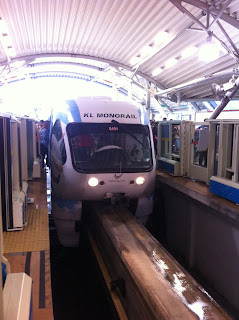 |
| Carol checking a camera trap on the trail |
Early October I arrived in Kuala Lumpur for work. The first
day I spent in TRAFFIC’s regional office in nearby Petaling Jaya. It was a
great chance to meet colleagues and get a better understanding of how Regional
Offices and Headquarters work together.
The following three days were spent at a fundraising
conference with TRAFFIC’s partner organisation, WWF. There were nearly 100
delegates from the region sharing experiences – success stories and challenges.
The work done by WWF and TRAFFIC in Asia Pacific is tremendously important.
Around 50% of the world’s species live in the Asia Pacific countries, and it is
home to some of the most fantastic (and threatened) rainforests. It was put very clearly at the conference why
conservation action is so important in this region:
There is no
sustainable planet earth without a sustainable Asia Pacific.
We learned about the Sumatran
rhino relocation effort, now desperate before the last few of these animals
are lost forever as their home range has been converted from forest to palm
plantation. We heard about the campaign to save the Snow Leopard,
the programme to double the number of the world’s Tigers (whose numbers are
going up in some regions, but not in Malaysia), and about many other projects
unique to the region.
 |
| Walking through the rainforest |
After the conference several delegates (including me) went
on a field trip up to Fraser’s Hill. We explored the forests first hand,
struggling with difficult paths, mosquitos and leeches. We learned from the
local conservation manager, Carol, about the endemic species found there such
as a lovely white orchid, and of other important fauna and flora. Fraser’s Hill
is a wonderful area, and also under threat from poaching. There are many plant and animal species that
are endemic (found nowhere else), and unscrupulous collectors are keen to add
rare specimens to their collections.
 |
| Fraser's Hill - the tall plants on the right are tree ferns |
But it wasn’t all bad news. During
our trip we enjoyed the opportunity to share our common love of nature and I
managed to see two lovely rare Langurs, as well as some beautiful birds. The field trip included WWF staff from many
countries including Mongolia, New Zealand, Japan, Pakistan, and our hosts WWF Malaysia.
We listened and learned, from our guide Carol, and from each other. All of us united in our aim to ensure that we
have a future as a species by not destroying the natural resources that we rely
upon, and that we enjoy simply for their beauty or uniqueness. Those people I spent a short, but important
time with, are now my friends as well as colleagues. I
would love to return to Fraser’s Hill if I ever get the chance – if for no
other reason than to spend some quality time bird watching!
























